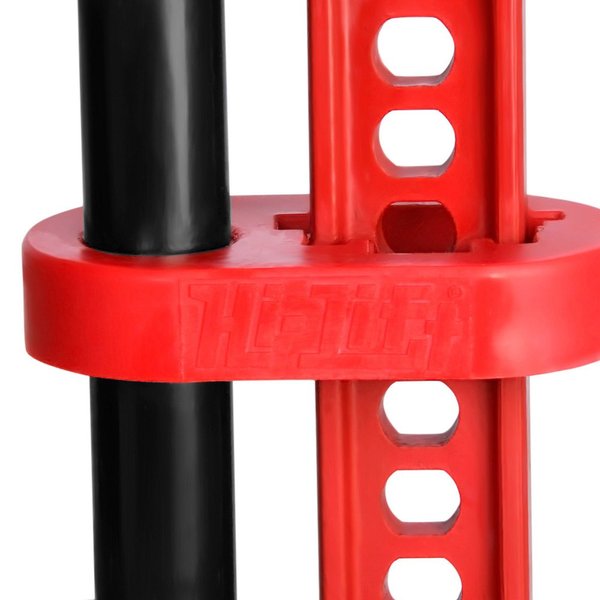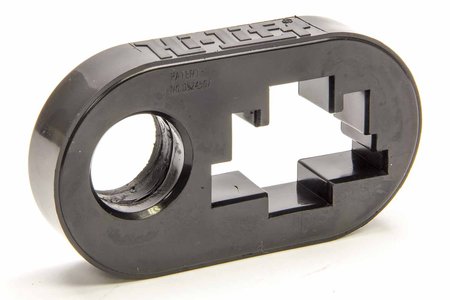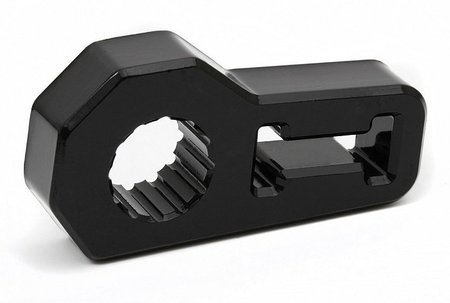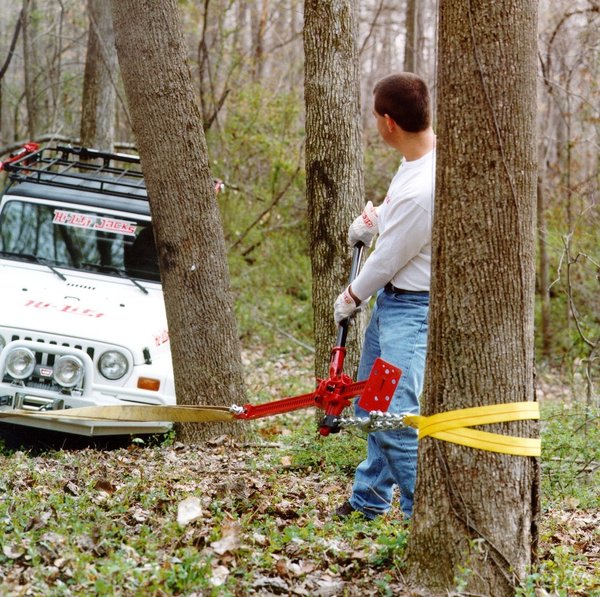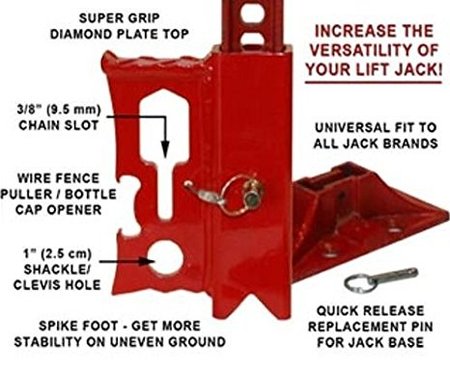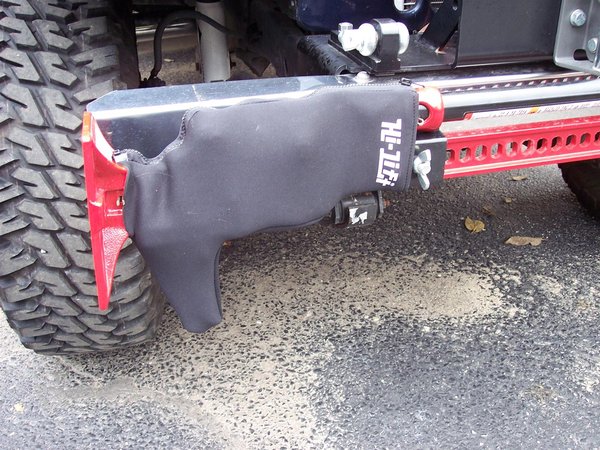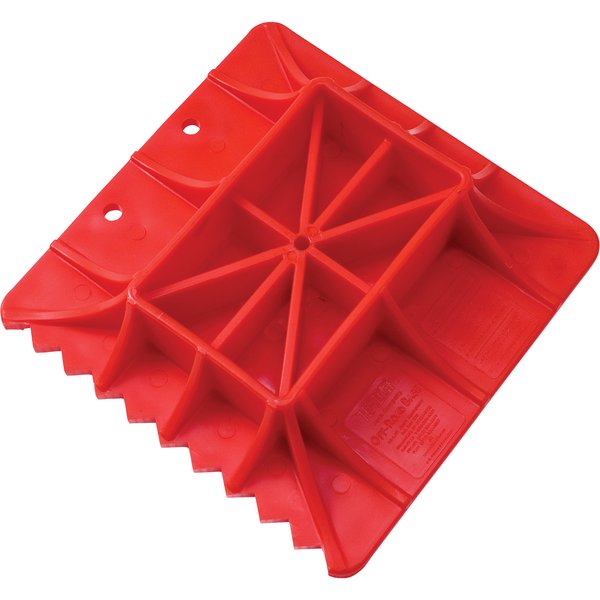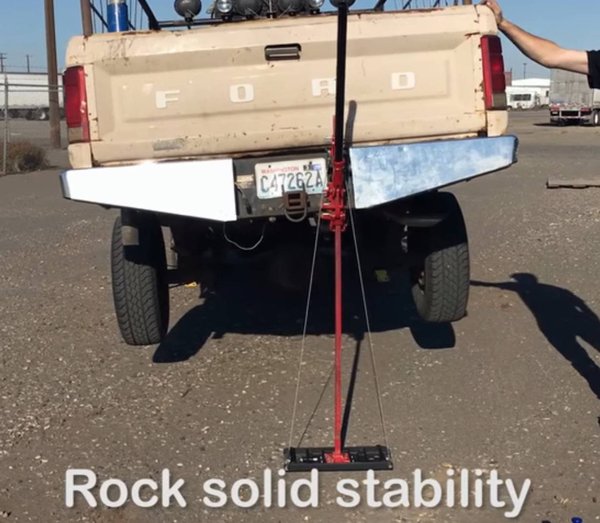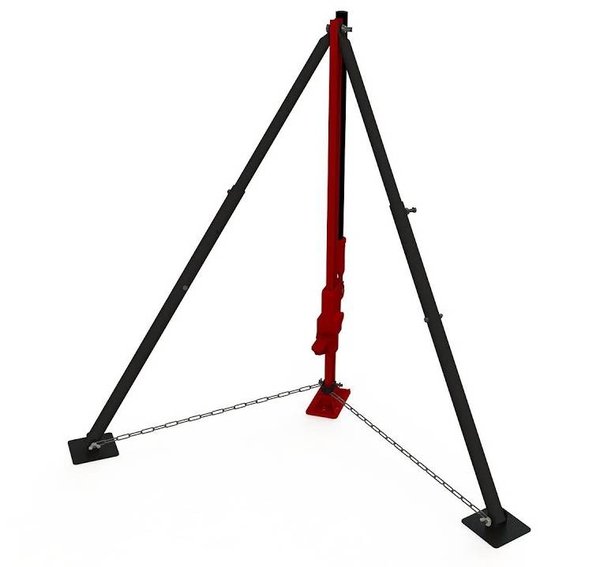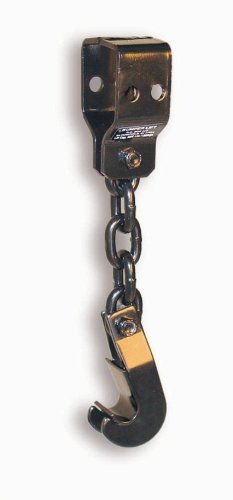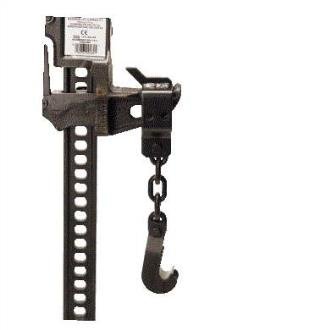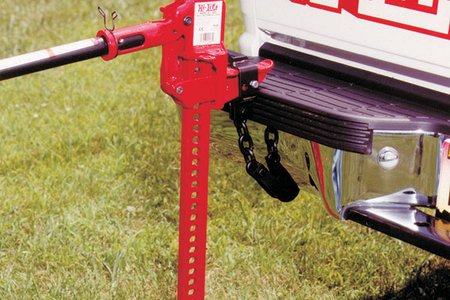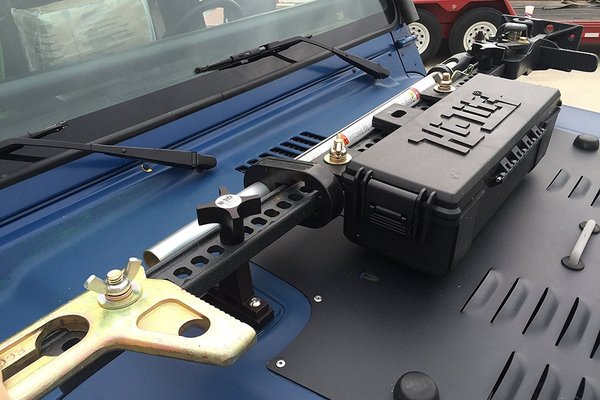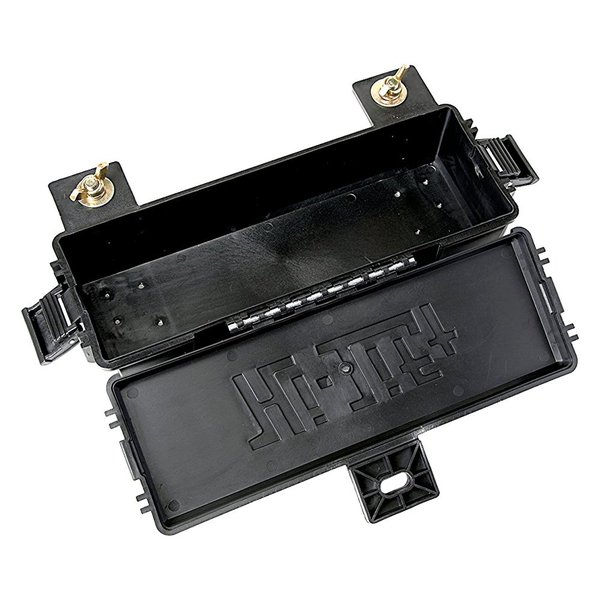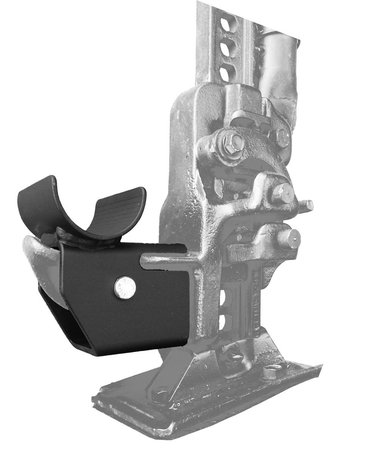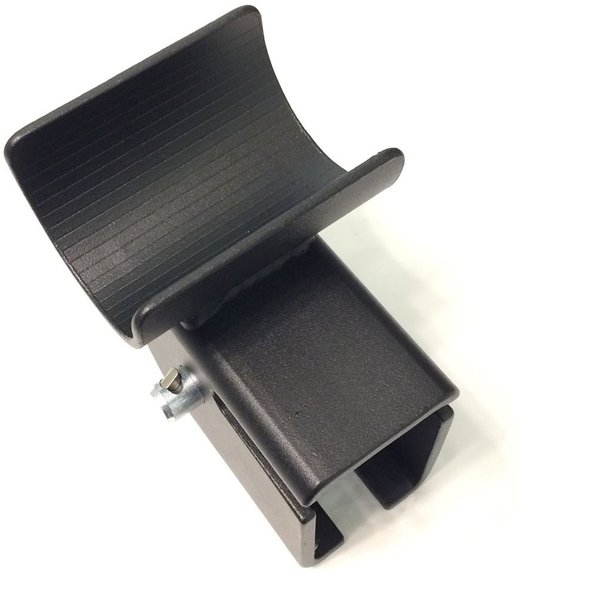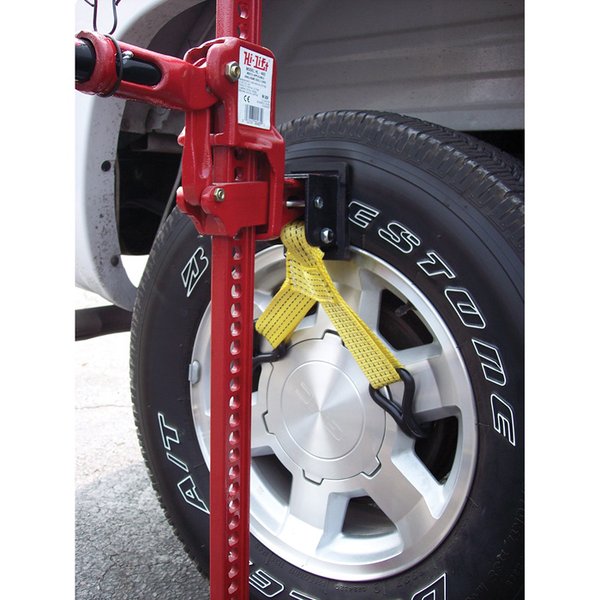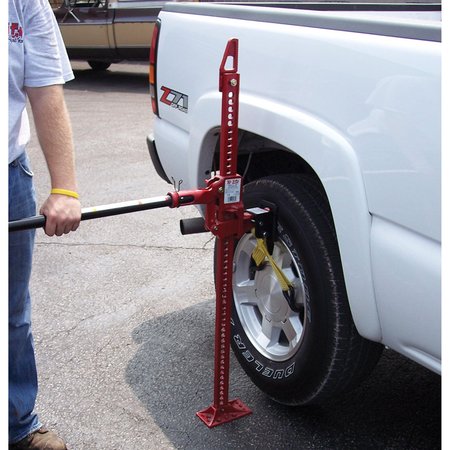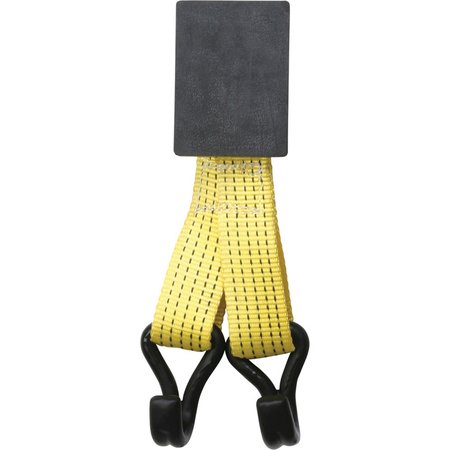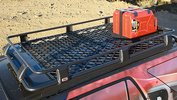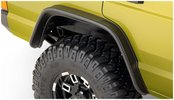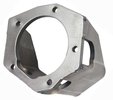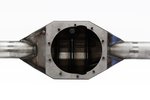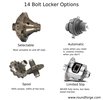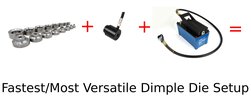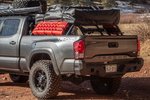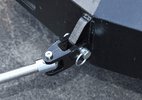The Best Hi Lift Jack Accessories
We all know that a Hi Lift jack can be one of the most helpful recovery accessories you can have in the backcountry. Lifting and maneuvering your 4x4 with your Hi Lift is a valuable ability when you're stuck in the middle of nowhere.
But what happens when you add some Hi Lift jack accessories to your off road recovery kit?
You can make it do a even more:
A Hi Lift jack is like a stock Jeep: it works pretty well by itself. But when you starting doing some upgrades, it can do things you never imagined.
In this article you'll get some ideas on how you can make your Hi Lift jack work even better for you.
- Hi Lift Jack Repair and Manual
- Cut the Rattles (Hi Lift Handle Keeper/Isolator)
- Prepare to Repair (Hi Lift Jack Repair Kit)
- Make Your Hi Lift into a Winch (Winch Kit)
- More Strength, More Options (JackMate)
- Stop the Rust (Hi Lift Jack Cover)
- Stabilize It (Off-Road Base)
- Make It More Stable (Steel Base Plate)
- Make It Even More Stable (Stabilizer Legs)
- Rescue Mall Crawlers (Bumper Lift)
- Tidy Up (Gear Storage Box)
- Jack From Your Rock Sliders (Tube Adapter)
- Lift with Wheel Straps (Hi-Lift Jack Lift-Mate)
- Protect Your Whole Jack (Hi Lift Jack Full Cover)
- Use Your Hi-Lift Jack as a Winch
- The Hi-Lift Jack Buyer's Guide
- A Hi Lift jack repair kit: for a spare shear bolt, load pins, and other small parts
- WD-40 or other lube: To keep it running smoothly
- Screwdriver: To nudge lifting pins that are rust-jammed
- A way to mount it: So it doesn't take out your skull when you roll over
- Keep the climbing pins lubed.
- Read the manual
- 2 climbing pins
- 2 springs for the climbing pins
- 2 cross pins
- 1 shear bolt
- 1 lube packet
- A Hi Lift winch kit
- A length of polyester strap or chain
- A length of Grade 80 chain that you can "ratchet" along
- It has a working load limit of 8000 lbs., which is far beyond the 750 lb. limit with the original clamp/clevis.
- The bottom notch can be used as a “spike foot” base replacement. If you flip the JackMate over, you can position objects in the same “V” for spreading two objects apart.
- Chain slot that takes a 3/8” (9.5mm) chain: This is super handy for winching and makes post-pulling super fast since the choker can be adjusted so quickly.
- 1” (2.5cm) clevis hole: This is probably the largest size most people will need and makes it easy to attach anything.
- Wire fence puller/bottle cap opener: Great for…pulling wire fences and opening bottles.
- Diamond plate pad: This is a little wider than the original clamp/clevis.
- Angle the jack slightly back when using this to minimize contact between the Bumper Lift and your bumper. Angling the jack inwards toward your 4x4 will likely dent bumpers that are made of thinner steel.
- Be aware that your jack will be prone to slide as the angle between your bumper and the jack increases or decreases from 90 degrees.
- Use this with strong, steel curved bumpers. The Bumper Lift can still dent thinner steel bumpers.
- Do not use on plastic bumpers.
- Aluminum bumpers might be okay as long as you determine that the aluminum is thick enough and sufficiently reinforced.
- The chain will scratch your bumper. Put some thick cloth or rubber there to protect it.
- You’ll lose about 8” of lifting height due to the length of the Bumper Lift, so plan accordingly.
- Angle the jack slightly away from your 4x4 to keep it from contacting your 4x4.
- You can also use the Lift Mate to raise your axle enough to put something under it. This is helpful if you need to service an axle or tire/wheel. Be very careful with this as you need to rest your axle on something large, heavy, wide, and stable.
- This Hi Lift accessory is not for winching. Use properly rated chain, shackles, and tree straps.
- Test fit the Lift Mate to ensure it works with your wheels.
Hi Lift Jack Repair and Manual
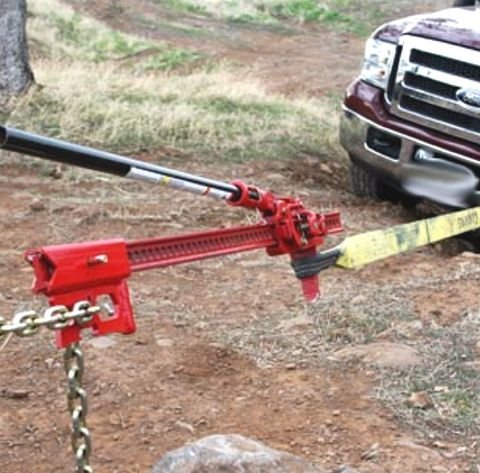
Don't have cash for a winch or need to do some dual-direction winching? You can do it with the factory clevis, but the JackMate is stronger and more versatile for winching.
Let's do the boring stuff first: maintenance and repair.
Why?
Speaking from experience, if your Hi Lift fails on the trail or the lift mechanism jams, your recovery operation will be 10 times harder and 10 times less safe. You haven't experienced true frustration until you've had to unjam rusty climbing pins on every pump of the jack handle.
Now:
There are a few of things you should always have with your Hi-Lift:
As you can see from our load rating chart, the Hi Lift can handle a lot of weight. There is a safety shear bolt that breaks at 7,000 lbs, but for most normal people doing normal lifting, this isn't an issue.
What if the shear bolt breaks?
You replace it with one from the repair kit and reconfigure how you're doing the recovery.
| Load or Even | Max weight | Notes |
|---|---|---|
| Lifting max weight from 4.5" - 48" | 4,660 lbs | 4.5" is the minimum jack height. |
| Lifting max weight from 48" - 60" | 2,660 lbs | |
| Winching max weight | 5,000 lbs | Top clamp clevis fails above 5,000 lbs |
| Clamping max weight | 750 lbs | Top clamp clevis fails above 750 lbs |
| Shear bolt breaks | 7,000 lbs | The climbing pins will still hold the load. |
One major problem is a jack mounted
outside a 4x4. The climbing pins are steel (stainless steel would be
weaker) and they'll eventually rust. Rusty climbing pins will bind and seize.
Binding literally only happens when you least want it to - like when you're trying to lower your rig on a rocky, uneven trail.
A jack cover (below) and regular lubrication can slow down rusting a lot, but a Hi Lift repair kit is small and super cheap insurance. It's easy to keep it in your recovery gear bag.
2 things you should do to keep your Hi-Lift working:
The
Hi Lift jack manual is short, high resolution, and has
easy-to-understand instructions. It's excellent, especially compared to
some other 4x4 parts manuals we've seen. Get it here:
Cut the Rattles (Hi Lift Handle Keeper/Isolator)
This isolator will slide right over the factory clevis on the end of the jack, making it easy to take off and put on.
Seriously, why doesn’t Hi Lift include a handle retainer with every jack? Hi-Lifts come with a metal spring clip that holds the handle in place against the bar, which is mostly useful to keep the handle upright when you pause while using the jack. This clip is fine if you keep your jack in the garage, but it is USELESS on a 4x4. The clip won’t hold the handle in place securely and it’s loose enough that it will rattle with every bump on the trail.
A handle keeper is the first accessory you should buy for your Hi-Lift Jack. Keepers are made from polyurethane and slide over the bar and handle to hold them separate and steady. With a secure mounting system, your jack will be silent.
This isolator will keep your handle in place and keep it from rattling. Rattling metal objects will usually grate away at you on the trail....
The Daystar isolator is a slightly tighter fit than the Hi Lift isolator, but doesn't have cutouts for the clevis.
Daystar makes a “handle isolator” which does not include the cutouts for the clamp-clevis nut and bolt, which means that for a few dollars savings you’ll be unbolting the clamp-clevis every time you want to remove the keeper. Some people report that the Daystar unit fits more snugly and that Hi Lift unit is looser.
Need a cheap fix?
Use a bungee cord. It’s a pain to put on and take off and it looks like hell, but it’ll do the job.
Prepare to Repair (Hi Lift Jack Repair Kit)
You should always carry a Hi Lift repair kit, some WD40 or other lube, and a screwdriver with you when you need your jack. The kit is cheap and can save you a lot of trouble on the trail.
This is one Hi-Lift accessory that you should always have in your toolbox. If your Hi-Lift’s mechanical parts stop working smoothly or it breaks on the trail, you’ll be glad to have some spare Hi Lift Jack parts in your tool box. This kit includes:
With enough use or time outside, the moving parts of your Hi-Lift will wear out. Sand, dirt, and rust can all affect your jack especially if you mount it outside your 4x4 without a cover.
Even though they are zinc-coated for corrosion resistance, eventually the climbing pins will wear through the zinc, rust, and stop moving smoothly in their bores. This can prevent your jack from climbing and lowering properly. You can temporarily remedy this in the field by lubing the pins and nudging them with the end of a screwdriver, but it’s easier to replace the pins in the long run. This kit replaces all the common wear parts and will make your jack work as good as new.
We strongly recommend against trying to replace your jack’s parts with hardware store pins and bolts unless you really know what you’re doing. You rely on the jack hardware to hold or pull the weight of your vehicle, and failure of the jack could have catastrophic consequences for anyone around your 4x4 in the event of a failure.
Make Your Hi Lift into a Winch (Winch Kit)
It's not as fast as a regular winch, but it'll definitely help to get you out of a bind. This would also be handy for stabilizing your rig or keeping your rig from sliding to the side when you're using your cable winch up front.
What can't it do?
With a winch kit and a chain, you can easily use your Hi Lift as a winch. This works nicely as a supplement to your main winch to stabilize your rig on off-camber recoveries. Or you can use it to recover when you're stuck. One of the main benefits is that you can "reel in" along a length of chain without resetting any of your gear. You simply can't do this without a Hi Lift winch kit.
Look:
This won't perform as well as an electric winch on the front of your truck. It's all manual power and will have a shorter reach. But it also doesn't require your engine to be running or charging your battery when you get stuck. Plus you already have the Hi Lift with you on the trails.
The best setup requires you to have:
More Strength, More Options (JackMate)
The JackMate is a quick-attaching tool that works at the bottom or the top of your Hi Lift, adding extra functionality and strength to your recovery operations.
Get higher weight ratings for winching and clamping!
The JackMate is an accessory for your Hi-Lift Jack that both improves its existing functions and makes it more versatile. It’s made by Rescue 42 and has been used for years in fire and rescue, farming, and industrial settings. In normal use it replaces the top clamp/clevis on your jack, adding significant strength and functionality. With its several improvements over the stock clamp-clevis, it’s probably the most useful Hi-Lift accessory:
The JackMate is basically a Swiss Army Knife for your Hi Lift.
Don't have cash for a winch or need to do some dual-direction winching? You can do it with the factory clevis, but the JackMate is stronger and more versatile for winching.
The JackMate is an awesome addition to your Hi-Lift. It would be worth it with only the chain slot and increased load limit. Besides all the standard stuff, it also works great for bending tie rods back into shape or popping out a fender that crunched into a tire after a roll.
Installation is a snap: you slide it on the bar and pop the pin in.
The JackMate is made to be used at either end of your Hi Lift and will slide anywhere on its bar. Since it’s designed to also be used as a base replacement it comes with a quick-release pin for the original Hi Lift base. This means that you can swap out the Hi Lift factory base for the JackMate without tools. Of all the Hi-Lift Jack accessories, this one is probably the most versatile.
Fitment
There have been fitment issues with the JackMate, but we don’t think it has to do with the JackMate itself.
We couldn’t find any reports of issues with Hi Lift brand jacks.
There are issues with “off-brand” jacks,
like Harbor Freight’s. Some of the Chinese jacks have inconsistent
tolerances such that a JackMate might not fit or easily slide along the
bar. Some of these jacks are fine, so if you get a JackMate, you should
check the fitment before relying on it.
Rescue 42 points out that older, frequently used jacks may have mushroomed ends or slightly bent bars which will make it hard to install the JackMate.
Stop the Rust (Hi Lift Jack Cover)
The cover has holes at both ends so that water that gets in can still get out.
Protect your jack's climbing pins from rust and dirt!
As we noted with the Hi Lift Repair Kit, corrosion and dirt are a big
problem with the Hi Lift jack mechanism. The moving parts get covered
in dirt and that makes them wear out faster. Or they rust and suddenly
your jack won’t lift and lower smoothly anymore.
The only fix is lots of
lube and replacement of the climbing pins.
The worst part is:
You only find out how badly your jack is working when you’re in the boonies trying to lift yourself off a rock that snagged your axle. What if you could avoid all this trouble?
You can! A neoprene cover for your Hi Lift jack is a pretty easy way to keep it protected. The cover fits snugly over the mechanical parts, but does not cover most of the bar or the handle. This means that you can use conventional Hi Lift jack mounts that mount the jack with the holes in the bar.
This cover is made from neoprene and zips over your jack. The zipper
in on the handle side of the jack, opposite the foot. Neoprene is
waterproof , but this cover is not waterproof. Why? For
one thing, the jack pokes through both ends of it. Water can also enter
and exit at the zipper and the seams opposite the zipper.
We recommend spraying WD-40 or lithium grease on your jacks mechanical parts when you put it away. The lube protects your parts, and the cover protects your lube. Between the lube and the cover, your jack will be protected from 99% of weather and dirt.
These covers come in black neoprene only, but you should expect it to fade to a light black/grey color. These covers last for about 1-3 years of constant sun exposure. The biggest complaint about them is the seam and material degradation in sun exposure.
Stabilize It (Off-Road Base)
Use it to keep from sinking into soft ground, sand, and mud. It's better than stacking rocks and can be used as a shovel if you're in a pinch.
You know what's worse than not having your Hi Lift?
Trying to lift up your 4x4 and having the jack sink slowly into the ground as you ratchet.
If you ever go wheeling in sand, mud, snow, or other soft ground this Hi-Lift jack accessory is worth its weight in gold. Usually you start looking around for logs and rocks that you can stick under your Hi-Lift. Ah yes, the old Hi-Lift-on-a-round-log trick.
What could go wrong?
Fortunately, you can buy a wide, lightweight accessory baseplate that
will go under your Hi-Lift and make it much more stable on flat
surfaces. The Hi-Lift jack base is made of thick, lightweight plastic and is 16” x
16”. The base does not attach to the bottom of the jack, instead having a
recessed area for the jack’s bottom pad.
While some people prefer an
attaching base, we’re fine with the loose recess attachment for increasing surface area. If you want great lateral stability with increased surface area, check out Safe Jacks' Hi-Lift baseplate below.
The base comes in a very visible red, which is good if you’re prone
to leaving recovery gear behind on the trail. It has a hole drilled in
the center that you can use to mount it to the bar of your Hi Lift for transport.
It does not come with mounting hardware, so if you want to mount it on the jack you’ll need a 4” x 5/16” bolt and a matching wing nut.
Make sure you use the base in appropriate situations - just because you have it doesn’t mean you always need to use it. Be cautious:
If you’re used to using the standard metal pad on your high lift, the plastic base may act differently on some surfaces. Sometimes your jack needs to bite into the ground and the large base won’t allow it.
One thing we like is the toothed edge - you can use this to scrape the ground and make it clear for the jack. This isn’t a replacement for a trail shovel, it’s more like, “I left my shovel at home, what can I use to get me out of here?” It’s a nice touch to get a little more versatility out of the base.
The cheap solution for a stabilizer:
Some 1” thick plywood or 1/4” steel plate will work reasonably well as a base. Neither has a recess for the jack unless you do a little woodworking or welding, so we’d suggest adding wood or metal to keep the jack from slipping off a homemade base.
Make It More Stable (Steel Base Plate)
This extra wide base plate makes your Hi Lift much more stable! Safe Jack also offers wide base plates for bottle jacks.
If the plastic base isn't for you, check out the steel jack base from Safe Jacks. This base plate has a smaller surface area at 8" x 14", but it also securely latches to your Hi-Lift.
Why do we love this base so much?
If it isn't obvious from the picture, this base makes a Hi-Lift super stable. The picture shows a truck being center-lifted from the rear hitch - something you should normally never do with your Hi-Lift.
But we can see that it's pretty stable - this works because of its attachment to your Hi-Lift.
The base secures quickly to your Hi-Lift with a spring loaded pin at the bottom and triangulated cables at the top. While it's a little more complicated with the cables, we like that the base and jack basically "become one". The cable attachment keeps the baseplate or pin from bending or breaking with harder lateral loads.
Comparing this to the above plastic base, the Safe Jacks base is 144 square inches vs 256 square inches for the plastic base - basically the plastic base is about 78% bigger.
In light of this, the plastic base is probably better for deep mud; the SJ base is better for situations where you need your Hi-Lift to be really, really stable.
Bonus feature:
The baseplate can also be used to stabilize bottle jacks, as long as they fit. Like a Hi-Lift, the plate will secure the bottle jack with a pin. This is great in soft sand/dirt/mud, since bottle jacks have a very small footprint and generally have low travel.
You might consider spraybombing this baseplate a brighter color. We have lots of dark colored recovery gear, but it makes it difficult to find it in the dark or when you toss it into brush.
The base plates are specific to 48" or 60" Hi-Lifts since the triangulating cables need to be different lengths.
Make It Even More Stable (Stabilizer Legs)
We don't see these stabilizer legs as being very useful for 4x4 use, but they'd make your Hi-Lift more stable for farm-type jobs.
If you need serious stability for your Hi-Lift, this is it:
The stabilizer leg kit from Safe Jacks.
There are some pretty clear pros and cons to using these legs.
With the two legs attached, your jack becomes a triangle, which is super stable. However, the legs protrude past the front of the jack, which really limits how you can use it while fourwheeling.
While you might be able to jack up the corner of your rig, you probably won't be able to jack up from a slider. This is pretty limiting for us fourwheelers.
The stability would work great for "farm jobs": pulling posts, yanking small stumps, and lifting equipment. We have a message out to Safe Jack about whether the legs could be used in a reverse configuration (pointing back), and we'll update this when we hear back from them.
The legs come in one size and can be adjusted to work with 48" or 60" Hi-Lifts.
Rescue Mall Crawlers (Bumper Lift)
The Bumper Lift's hook and chain setup allow it to attach around conventional curved bumpers so that you can lift any vehicle - not just those with a sufficient flat area.
Need to lift a stock curved bumper?
Good luck.
Your Hi-Lift Jack has a flat lifting point, which is great for square
or rectangle tube bumpers. But the jack stinks when you need to lift a
vehicle with rounded bumpers.
Besides being prone to denting or crumpling your bumper, the flat lift point is very unstable under a curved bumper since the contact points are so small. The lack of friction means that your jack can easily slip. In some cases, the lift point on the Hi Lift is not even long enough to reach a “grab point” on the bumper.
Not anymore:
The Bumper Lift is a Hi Lift Jack accessory that makes lifting from a curved bumper much easier and safer. It’s made from steel and bolts to your Hi Lift. It can lift up to 3000 lbs. which should be enough for most 4x4s. Normally you’ll be using it to lift only one corner of your vehicle, so the Bumper Lift only needs to hold a fraction of your 4x4s total weight. For most people the front of the 4x4 will be heavier than the rear due to the weight of the engine and transmission.
The Bumper Lift attaches quickly and easily.
The Bumper Lift will let you use your Hi Lift with any bumper. However, be aware that very thin bumpers can dimple from use, especially if the jack angle forces the chain into the bumper.
Usage Tips:
Tidy Up (Gear Storage Box)
The gear box can still clear your hood when mounted to a hood-mounted jack.
If storage space is at a premium in your Jeep or 4x4, this storage box is a decent accessory for your Hi-Lift Jack. Being made from metal-reinforced plastic, it’s very solidly built. It has two holes spaced to bolt to the bar of your Hi Lift.
The box is 15-1/2” x 5-1/8” x 4”. That’s deep enough to fit a coiled recovery strap. The included mounting hardware comes with large wingnuts that are easy to spin off when you need to use your jack.
We wish the box was waterproof, but it isn’t. It has a raised lip that should keep most water out if mounted horizontally, but it definitely is not submersible. We wouldn’t keep any tools in it that would have a real problem with rust and corrosion. So storing ratchets, sockets, wrenches, pliers, and so on would probably be a bad idea, but it would be perfect for Hi Lift Jack accessories, recovery straps, or shackles.
The box has a third hole that can be used with a padlock or locking
knob (neither are included) to lock it to your jack. We wish the locking
mechanism was done a little better since locking it could be a little
tricky.
The locking hole is located on the box lid and the mounting
holes are located on the box bottom. With the box locked to your Hi
Lift, the mount bolts could be removed and the side latches unfastened.
This would allow the box bottom to swing down and open. If the assembly
was mounted directly above a hood or other surface this probably
wouldn’t be too much of a problem since the box bottom would contact
your hood.
You could secure the box bottom with a knob lock and use a padlock or knob lock on the locking hole, but at that point your Hi Lift will be covered in locks and you might want to reevaluate what you’re storing, how much those items are worth, and whether there is a better solution.
Jack From Your Rock Sliders (Tube Adapter)
This adapter is made in the USA and powdercoated to have a durable, long-lasting finish. It fits any round tube up to 2.25" OD.
Sometimes you need to lift your rig up on the side, but tube sliders can make that difficult! Not with this adapter!
This adapter not only fits rock sliders, but it'll also fit tube bumpers. Basically, anywhere you need to lift at a tube, this is the adapter.
Have you tried jacking from your round tube rock sliders?
Did you survive?
Just like with curved bumpers, the Hi Lift's flat
lifting nose is not very secure on round tube rock sliders or tube bumpers. This
adapter solves that problem with a half round tube that can be used on
sliders and bumpers that are up to 2.25” in diameter.
The Slider Adapter is made from steel and powdercoated black to have a long-lasting finish. It attaches to the Hi Lift nose with an included autolocking pin.
The Slider Adapter makes a larger contact area for your Hi Lift to lift your 4x4 and will help to prevent your rig from sliding off your jack.
As long as your sliders can support the weight of your 4x4 this
accessory will work for you. This includes sliders that are welded or
bolted to the frame, as long as that connection is secure. Welded
sliders should use fish plates instead of being butt-welded directly to
the frame. Bolted sliders should use appropriately sized grade 8
hardware.
Don’t use this adapter on sliders that are cosmetic or made of thin material, since they’ll dent and bend.
Of course, this adapter will also work on tube bumpers with a tube diameter of up to 2.25". Again, your bumper should be built to be used as a lifting point and securely bolted or welded to your frame.
When you need confidence in lifting from your sliders, this is a sturdy Hi Lift accessory made in the USA. This will not fit Hi Lifts made in the 1980’s with a short nose. It will fit First Responder Jacks.
This adapter will also not fit Smittybilt farm jacks (the 2722 model).
Not to worry, Lotus Development also makes a tube adapter that fits the Smittybilt.
Lift with Wheel Straps (Hi-Lift Jack Lift-Mate)
The Jack Mate will be kinder to your wheels than running a chain through the spokes, plus it'll stay attached to the jack better than a chain!
The Hi-Lift Jack Lift Mate is perfect when you need to get a wheel up for some reason but you run out of jack. It’s an underrated Hi-Lift accessory that works extremely well. Sometimes you get high-centered or stuck on some obstacle. It could be a rock, a ledge, a sand dune, a tree stump, a log, or a deep rut in a muddy area. Often, you can jack up your 4x4 at the bumper or slider, put a rock or log under it, lower your tire onto the rock or log, and drive away. This technique won’t work if you have a super-flexy suspension, or just happen to be badly positioned, because your Hi Lift will be too short. With a lot of suspension travel, some rigs will max out the jack before lifting a tire.
The Hi-Lift Lift Mate fixes that problem by attaching directly to your wheel. By lifting your wheel directly, you don’t need to worry about the flexiness and travel of your suspension. It’s also safer than lifting at the bumper or slider because you won’t be lifting your rig up to some crazy height just to get a rock under the tire. While this might not be a big deal on level ground, on an off-camber trail a high center of gravity and high angle could put your 4x4 in a precarious position.
If you stack rocks on the trail, make sure you unstack them to keep the trails tough and fun!
The Lift Mate is super handy on the trail when you need to jack up a tire or the whole side of your rig, especially when you're stuck on an obstacle.
The Hi Lift Lift Mate is rated for 5000 lbs. This should be fine for
most 4x4s since you’ll only be lifting one wheel at a time. The hooks
are made from 1/2” OD steel that are coated with rubber.
The hooks are large enough to fit stamped steel wheels and most aluminum wheels. Some aluminum wheels are too thick for the hooks, so you should test fit the Lift Mate when you get it to be sure it works with your wheels. The hooks are versatile enough that you could use them to lift anything with an edge within the weight rating, like a bumper or a mower deck.
The Lift Mate attaches to your Hi Lift with the included 5/16” bolt.
Usage Tips
If you’re on a budget:
You can crawl under your 4x4 and wrap chain or a sturdy strap around your axle and frame to prevent your suspension from downtraveling. This isn’t as effective as the Lift Mate due to jack positioning and slack in the chain, but it works.
Protect Your Whole Jack (Hi Lift Jack Full Cover)
Depending on where you store your jack, this is a Hi-Lift accessory
that you may want. This full-length jack cover is made from heavy duty
reinforced canvas. It has a full length heavy-duty metal zipper. It has a
carrying handle that makes lugging it around a little easier. Hi Lift
used to make a hated vinyl jack cover that got holes in it and tore
easily, but this version, which came out in 2015, is much sturdier.
The JP-350 cover fits 48” Hi Lift Jacks and the JP-360 fits 60" Hi Lift Jacks.
JP-350 cover for 48” Hi Lift Jacks
JP-360 cover for 60” Hi Lift Jacks
Be aware that the cover really only protects your jack from dirt, dust, and light rain. It’s not waterproof and it has no provisions for mounting your jack. Any Hi Lift Jack mount that uses the bar cannot be used with this cover. Additionally, it may muffle rattling noises but it won’t work as well as a handle keeper.
Last updated: September 5, 2019
